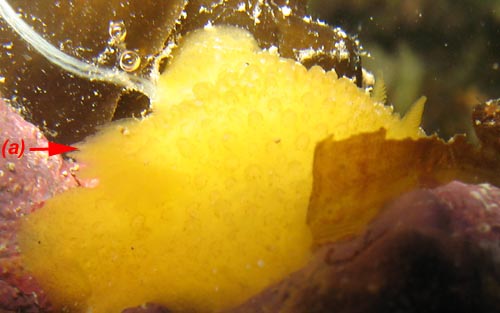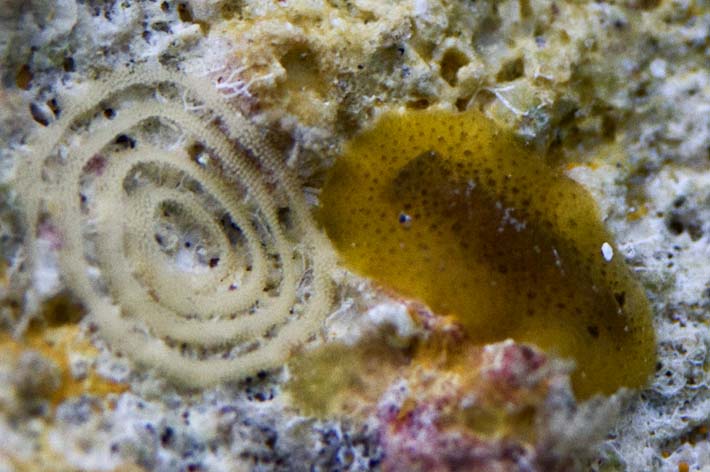This species has been observed on Reunion and Mauritius Islands
It is characterised by the arrangement of the gills in a transverse line across the back. There is a dorsal flap covering the gill opening All the mantle is covered in evenly sized low rounded tubercles It ranges in colour from a pale yellow-orange to a dark green |

|
|
| Showing species characteristics... | Photo Christophe Cadet |
|
Remarks :
Identification confirmed by Nathalie Yonow
Specimens of Doriopsis are either deep blue, green or yellow and there has been considerable confusion in the literature concerning how many species there are in the genus. At one extreme 4 species, one each of green and blue and two of yellow have been suggested, while at the other extreme only one variably coloured species has been proposed
Biological observations from throughout the Pacific suggest that there are at least two species, one yellow or green (Doriopsis granulosa) and one deep blue (Doriopsis pecten).
In Reunion Island we found strange specimens called for the moment Doriopsis cf pecten . This specimen eats a yellow sponge like D. granulosa, but have a blue criss cross pattern like D. pecten !!!!
Doriopsis granulosa
Doriopsis pecten
Size
38 mm (18 to 25 is usual for adult)
10 mm
16 mm (7 to 8 mm is usual for adults)
Dorsum
All the mantle is covered in evenly sized low rounded tubercles
Mantle covered with numerous small pustules, some higher in the axis of the back (or dirt often cling)
The raised central region is usually paler, almost translucent in colour, with a criss-cross pattern caused by the underlying spicules in the skin
Colour
It ranges in colour from a pale yellow-orange to a dark green
The mantle is blue-green to dark blue-green.
The mantle is blue, sometimes so dark are to appear almost black
Food
Found feeding on a yellow or orange sponge, which is probably Prianos phlox
Found feeding on a yellow or orange sponge
Found feeding exclusively on a deep blue sponge Terpios
Spawn
The eggs are reported to be yellow and is much larger, and sturdier.
The eggs are reported to be cream to white with a frilly edge, and quite small and delicate
Bibliographic data :
It ischaracterised by the arrangement of the gills in a transverse line across the back rather than in the typical dorid circle. There is a dorsal flap covering the gill opening
In yellow-green specimens the tubercles have scattered brown specks, especially on the sides, while in dark green animals the tubercles are often completely brown
The body feels very firm because the skin is toughered with tiny rods (spicules) and the mantle is rough to the touch
The rhinophores and gills are the same colour of the body without any speckling
The 15 to 17 simple gills for a circlet around the anus that is compressed into a rearward-projecting fan overstopped by a notal flap
Found under stones and rubble from the intertidal zone to a about 3 m depth where its feeds on yellow sponges and can be extremely cryptic
The spawn consists of a bright yellow coil of 5 or 6 whorls
References :
Bill Rudman Seaslug site : Sea Slug Forum : Doriopsis granulosa
Nudipixel Doriopsis granulosa
Publications :
Baba, K. & Hamatani, I., 1961. On two new species of Doriopsis (syn. Ctenodoris ) from Japan (Nudibranchia - Dorididae). Publications of the Seto Marine Biological Laboratory, 9 : 63-65.
Bertsch, H. & Johnson, S., 1981. Hawaiian Nudibranch s. Honolulu: Oriental Publishing Co
Collingwood, C. (1881). On some new species of nudibranchiate mollusca from the Eastern Seas. Transactions of the Linnean Society, London, Zoology, 2 : 123-140, Pls 9-10.
Hamatani, I, 1961. Notes on veligers of Japanese opisthobranchs(4). Publications of the Seto Marine Biological Laboratory, 9(2) :353-361
Johnson, S., 1981. Blue camouflage in a nudibranch. Hawaiian Shell News, 29(6) : 14
Kay, E.A. & Young, D.K., 1969. The Doridacea (Opisthobranchia: Mollusca) of the Hawaiian Islands. Pacific Science, 23 : 172-231
Pease, W.H. (1860). Descriptions of new species of mollusca from the Sandwich Islands. Proceedings of the Zoological Society of London, 28 : 18-37
Young, D.K., 1967. New records of Nudibranchia from the Central and West-Central Pacific with a description of a new species. The Veliger, 10 : 159-173
Other photos of Doriopsis granulosa :
 |
Christophe Cadet Reunion, Etang salé lagoon, less 1 m, 27 March 2010, size : 15 mm The eggs are reported to be yellow and is much larger, and sturdier. The spawn consists of a bright yellow coil of 5 whorls |
|
Philibert Bidgrain Reunion, La Saline lagoon, less 1 m, 1 March 2010, size : 20 mm |
|
||||
 |
 |
Christophe Cadet Reunion, Etang salé, on the rocky coast, less 1 m, 26 October 20009, size : 5mm A juveline, always with low rounded tubercles over all the mantle |
Elisanbeth Morcel Réunion, 9 December 2015
Considered by some specialist as Doris (Doriopsis) viridis and as Doriopsis granulosa by others... |
 |
More photos from Indian Ocean
Reunion, one juvenile and two adults of D. granulosa, at La Saline, by Philibert Bidgrain
Mauritius, D. granulosa, at Pointe d'Esny, by Geoffrey Summers

